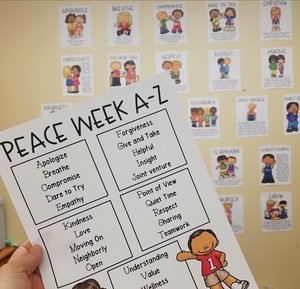After reading Peace Week in Mrs. Fox’s Class to a group of second graders, it got me thinking and what would happen if I tried to implement a peace week of my own at my school. We’ve created a culture of kindness for our students, why not create a culture of calm?
I built a week into our school schedule where creating peace is the main focus. Students are heavily encouraged to look for peaceful solutions to common stressful situations. They are challenged to think of ways they can help promote peace at school.
Here are six ways I created a culture of calm at my school through the use of a school-wide Peace Week:
Define Each Classroom’s Idea of Peace Week
No two classrooms are exactly alike. What is peace week going to look like in each classroom? How are students going to make it their own? Have students describe and discuss what a peaceful week at school would look like and how they could make it happen.
I use these posters to have students brainstorm the qualities and actions of a peaceful person.
Next, I ask students questions that get them thinking, such as: What is a peaceful person like? What qualities do they have? What type of responses would they have in stressful situations?
Think about common situations that break the peace at your school. Roleplay various student responses and think about if those reactions help keep the peace or break the peace.
Peace Week Contracts
What rules/expectations do your students agree to follow and expect from each other? What happens when someone breaks the peace? Take time to have your students come up with the rules, expectations, norms, and criteria for how they expect each other to participate and contribute to peace week.
Having a “peace week rulebook” of sorts that contains the agreed-upon expectations for peace week will help everyone understand the guidelines. Students can use this as a model for ways to promote peace, or as a tool to help guide students who need help understanding how to keep the peace.
This “peace week rulebook” can easily be in the form of a contract-like document. This document outlines expectations for peace week behaviors that all students create together and sign to show their commitment. All teachers can display their peace week contracts outside of their classroom door as an instant reminder of peace week expectations each time students enter the classroom.
Promote the Students’ Idea of Peace Week
Have students take ownership of what they think Peace Week represents. Having the kids take control of the creation and promotion of Peace Week helps with student buy-in and increases student’s desire to participate. Have students create a schedule of daily dress up days or a student showcase on the school news explaining how a student kept the peace. Activities like these cause an amazing transformation in your school climate leading to a bit more peace in your hallways.
Take Advantage of Teachable Moments
As educators, we have to allow students the freedom to find peaceful solutions to their conflicts. Occasionally, we can help guide them along the way. When a conflict occurs, acknowledge something happened that broke the peace and help students brainstorm solutions to regaining the peace. Roleplay ways that students could better handle the situation in the future. Help model ways that students can come to a compromise, move past the conflict and return to a state of peace.
Peace Week Trackers
Creating peace week trackers can be very useful tools that help students visualize all the good they are doing in their school community. Trackers are also great for keeping the morale around peace week high. If students witness an interaction that helped keep the peace, they can track it on their classroom peace week trackers. Peace week trackers are a great way for students to continue the conversation about peaceful reactions and to give students a way to hold each other accountable.
Peaceful Pauses
Building time into your schedule for students to find inner peace can completely change the climate of the room. Taking the time to create a calm, peaceful learning environment can lead to many positive benefits. The main benefits are improved focus and increased academic endurance.

I like to watch YouTube videos or read stories that promote mindfulness. We also practice breathing strategies and visualization, reviewing various self-control or calm down strategies and utilize the peaceful poses of yoga. A zen corner is perfect to help my students find peace within themselves that they can later share with the school.
Using the six tips above, you can create a shift in student’s mindsets. That shift will help your school adopt a school-wide expectation of peace. Teach students to look for ways to help keep the peace. In the process, help create a calm environment that allows all students to find peace within themselves.
How do you promote peace and create a culture of calm within your school?
Leave a comment below!








